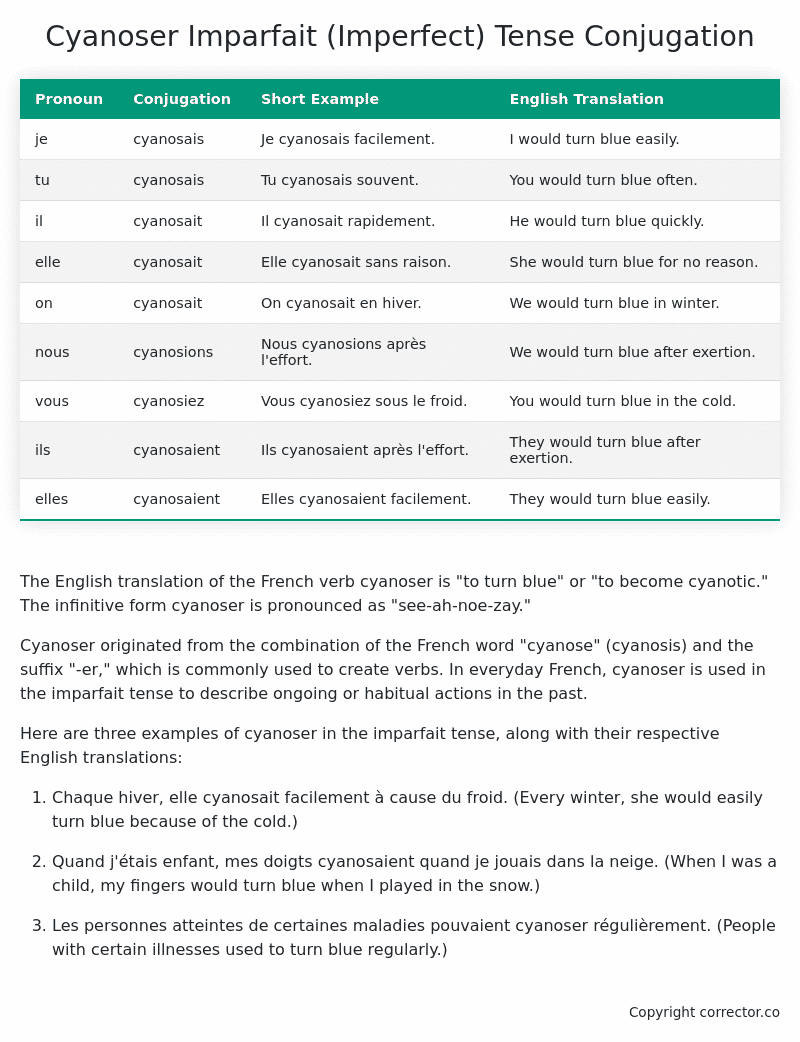Imparfait (Imperfect) Tense Conjugation of the French Verb cyanoser
Introduction to the verb cyanoser
The English translation of the French verb cyanoser is “to turn blue” or “to become cyanotic.” The infinitive form cyanoser is pronounced as “see-ah-noe-zay.”
Cyanoser originated from the combination of the French word “cyanose” (cyanosis) and the suffix “-er,” which is commonly used to create verbs. In everyday French, cyanoser is used in the imparfait tense to describe ongoing or habitual actions in the past.
Here are three examples of cyanoser in the imparfait tense, along with their respective English translations:
-
Chaque hiver, elle cyanosait facilement à cause du froid.
(Every winter, she would easily turn blue because of the cold.) -
Quand j’étais enfant, mes doigts cyanosaient quand je jouais dans la neige.
(When I was a child, my fingers would turn blue when I played in the snow.) -
Les personnes atteintes de certaines maladies pouvaient cyanoser régulièrement.
(People with certain illnesses used to turn blue regularly.)
Table of the Imparfait (Imperfect) Tense Conjugation of cyanoser
| Pronoun | Conjugation | Short Example | English Translation |
|---|---|---|---|
| je | cyanosais | Je cyanosais facilement. | I would turn blue easily. |
| tu | cyanosais | Tu cyanosais souvent. | You would turn blue often. |
| il | cyanosait | Il cyanosait rapidement. | He would turn blue quickly. |
| elle | cyanosait | Elle cyanosait sans raison. | She would turn blue for no reason. |
| on | cyanosait | On cyanosait en hiver. | We would turn blue in winter. |
| nous | cyanosions | Nous cyanosions après l’effort. | We would turn blue after exertion. |
| vous | cyanosiez | Vous cyanosiez sous le froid. | You would turn blue in the cold. |
| ils | cyanosaient | Ils cyanosaient après l’effort. | They would turn blue after exertion. |
| elles | cyanosaient | Elles cyanosaient facilement. | They would turn blue easily. |
Other Conjugations for Cyanoser.
Le Present (Present Tense) Conjugation of the French Verb cyanoser
Imparfait (Imperfect) Tense Conjugation of the French Verb cyanoser (You’re reading it right now!)
Passé Simple (Simple Past) Tense Conjugation of the French Verb cyanoser
Passé Composé (Present Perfect) Tense Conjugation of the French Verb cyanoser
Futur Simple (Simple Future) Tense Conjugation of the French Verb cyanoser
Futur Proche (Near Future) Tense Conjugation of the French Verb cyanoser
Plus-que-parfait (Pluperfect) Tense Conjugation of the French Verb cyanoser
Passé Antérieur (Past Anterior) Tense Conjugation of the French Verb cyanoser
Futur Antérieur (Future Anterior) Tense Conjugation of the French Verb cyanoser
Subjonctif Présent (Subjunctive Present) Tense Conjugation of the French Verb cyanoser
Subjonctif Passé (Subjunctive Past) Tense Conjugation of the French Verb cyanoser
Subjonctif Imparfait (Subjunctive Imperfect) Tense Conjugation of the French Verb cyanoser
Subjonctif Plus-que-parfait (Subjunctive Pluperfect) Tense Conjugation of the French Verb cyanoser
Conditionnel Présent (Conditional Present) Tense Conjugation of the French Verb cyanoser
Conditionnel Passé (Conditional Past) Tense Conjugation of the French Verb cyanoser
Conditionnel Passé II (Conditional Past II) Tense Conjugation of the French Verb cyanoser
L’impératif Présent (Imperative Present) Tense Conjugation of the French Verb cyanoser
L’impératif Passé (Imperative Past) Tense Conjugation of the French Verb cyanoser
L’infinitif Présent (Infinitive Present) Tense Conjugation of the French Verb cyanoser
L’infinitif Passé (Infinitive Past) Tense Conjugation of the French Verb cyanoser
Le Participe Présent (Present Participle) Tense Conjugation of the French Verb cyanoser
Le Participe Passé (Past Participle) Tense Conjugation of the French Verb cyanoser
Struggling with French verbs or the language in general? Why not use our free French Grammar Checker – no registration required!
Get a FREE Download Study Sheet of this Conjugation 🔥
Simply right click the image below, click “save image” and get your free reference for the cyanoser imparfait tense conjugation!

Cyanoser – About the French Imparfait Tense
NOTE: To take a deep dive into all the French tenses then see our article on Mastering French Tense Conjugation.
Formation of the Imparfait Tense
For regular -er verbs:
For regular -ir verbs
For regular -re verbs
Common Everyday Usage Patterns
Description of Past Habits
Background Information
Mental and Emotional States
It’s employed to express emotions, thoughts, or physical sensations in the past. For example: “J’étais content quand il est arrivé.” (I was happy when he arrived.)
Ongoing Actions
Points to Note About the Imparfait Tense
Passé Composé vs. Imparfait
Conditional
Si Clauses
Narration
I hope you enjoyed this article on the verb cyanoser. Still in a learning mood? Check out another TOTALLY random French verb imparfait conjugation!


